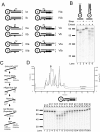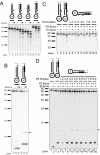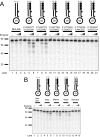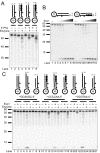A sequence-dependent exonuclease activity from Tetrahymena thermophila
- PMID: 21080963
- PMCID: PMC2998447
- DOI: 10.1186/1471-2091-11-45
A sequence-dependent exonuclease activity from Tetrahymena thermophila
Abstract
Background: Telomere function requires a highly conserved G rich 3'- overhang. This structure is formed by 5'-resection of the C-rich telomere strand. However, while many nucleases have been suggested to play a role in processing, it is not yet clear which nucleases carry out this 5'-resection.
Results: We used biochemical purification to identify a sequence-dependent exonuclease activity in Tetrahymena thermophila cell extracts. The nuclease activity showed specificity for 5'-ends containing AA or AC sequences, unlike Exo1, which showed sequence-independent cleavage. The Tetrahymena nuclease was active on both phosphorylated and unphosphorylated substrates whereas Exo1 requires a 5'-phosphate for cleavage.
Conclusions: The specificities of the enzyme indicate that this novel Tetrahymena exonuclease is distinct from Exo1 and has properties required for 3'-overhang formations at telomeres.
Figures






Similar articles
-
G-overhang dynamics at Tetrahymena telomeres.EMBO J. 2001 Aug 1;20(15):4299-308. doi: 10.1093/emboj/20.15.4299. EMBO J. 2001. PMID: 11483532 Free PMC article.
-
Distinct activities of exonuclease 1 and flap endonuclease 1 at telomeric g4 DNA.PLoS One. 2010 Jan 26;5(1):e8908. doi: 10.1371/journal.pone.0008908. PLoS One. 2010. PMID: 20126648 Free PMC article.
-
Generation of telomeric G strand overhangs involves both G and C strand cleavage.Mol Cell. 2003 Apr;11(4):1021-32. doi: 10.1016/s1097-2765(03)00131-x. Mol Cell. 2003. PMID: 12718887
-
EXO1: A tightly regulated nuclease.DNA Repair (Amst). 2020 Sep;93:102929. doi: 10.1016/j.dnarep.2020.102929. DNA Repair (Amst). 2020. PMID: 33087266 Review.
-
Integrative structural biology of Tetrahymena telomerase - insights into catalytic mechanism and interaction at telomeres.FEBS J. 2016 Jun;283(11):2044-50. doi: 10.1111/febs.13691. Epub 2016 Mar 17. FEBS J. 2016. PMID: 26918633 Free PMC article. Review.
Cited by
-
Early and late steps in telomere overhang processing in normal human cells: the position of the final RNA primer drives telomere shortening.Genes Dev. 2012 Jun 1;26(11):1167-78. doi: 10.1101/gad.187211.112. Genes Dev. 2012. PMID: 22661228 Free PMC article.
References
-
- Harley CB. In: Methods in Mol Biol. Pollard JW, Walker JM, editor. Vol. 5. Clifton, NJ:The Humana Press Inc.; 1990. Aging in cultured human fibroblasts; pp. 25–32. - PubMed
Publication types
MeSH terms
Substances
Grants and funding
LinkOut - more resources
Full Text Sources

